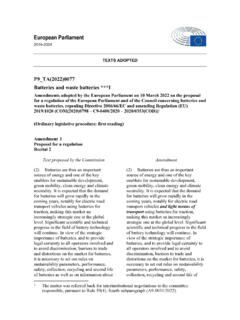Transcription of A Technical Research Report: The Electric Vehicle
1 March 11, 2010 A Technical Research Report: The Electric Vehicle Prepared for Ann Holms University of California Santa Barbara College of Engineering Prepared By Rony Argueta University of California Santa Barbara College of Engineering Abstract Due to the problems caused by the gasoline engine on the environment and people, the automotive industry has turned to the electrical powered Vehicle . This report explains how an Electric Vehicle works and compares the Electric Vehicle to the internal combustion engine and hybrid Vehicle . The report provides some of the advantages and disadvantages of the Electric Vehicle . In addition, a brief future view of the technology is given. Table of Contents Introduction ..1 Electric Vehicle (EV) History ..1 Description of an Electric Vehicle ..2 Description of Parts and their Functions ..3 Theory of Operation for EV ..3 Description of a Hybrid Vehicle ..3 Description of Parts and their Functions.
2 4 Theory of Operation for Hybrid ..5 Comparison of Combustion Engine, Hybrid and Electric ..5 Efficiency ..5 Speed/Acceleration ..5 Maintenance ..6 Mileage ..6 Cost ..6 Advantages and Disadvantages of the EV ..6 Emissions ..7 Global Warming: Ozone Layer ..7 Affected People: Future of the Conclusion ..8 References ..9 List of Figures Figure 1. Parts of an Electric Vehicle ..2 Figure 2. Parts of a hybrid Vehicle ..4 List of Tables Table 1. Comparison between the ICE, HV, and EV ..5 Table 2. Advantages and Disadvantages of the EV ..6 Argueta - 1 Introduction The 1960s and 1970s saw a need for alternative fueled vehicles to reduce the problems of exhaust emissions from internal combustion engines and to reduce the dependency on imported foreign crude oil. During the years from 1960 to the present, many attempts to produce practical Electric vehicles occurred and continue to occur. The purpose of this report is to describe the technology used to produce an Electric Vehicle and explain why the Electric engine is better than the internal combustion engine.
3 It includes reasons why the Electric Vehicle grew rapidly and the reason it is a necessity to better the world today. The report describes the most important parts in an Electric Vehicle and hybrid Vehicle . It compares the Electric to the hybrid and internal combustion engine Vehicle . It also includes the future of the Electric Vehicle . The overall impact of the Electric Vehicle ultimately benefits the people. Compared to gasoline powered vehicles, Electric vehicles are considered to be ninety-seven percent cleaner, producing no tailpipe emissions that can place particulate matter into the air. Particulate matter, carcinogens released into the atmosphere by gas-powered vehicles, can increase asthma conditions, as well as irritate respiratory systems [1]. The paper begins with a history of the Electric Vehicle , specifically the lows and highs of production and the reasons for the change. The next section provides a Technical description of an Electric Vehicle , including the parts, their functions, and the theory of operation.
4 The following section describes the hybrid car, including parts, their functions and the theory of operation. Based on this understanding, I then compare the internal combustion engine, the hybrid engine, and the electrical engine in terms of efficiency, speed, acceleration, maintenance, mileage, and cost. The paper concludes with sections on the advantages and disadvantages of the Electric Vehicle and its future. Electric Vehicle (EV) History The first Electric Vehicle (EV) was built between 1832 and 1839, the exact year is not known, in Scotland by Robert Anderson, who created the first crude Electric carriage. It was not until 1895, after Ryker built an Electric tricycle and William Morrison built a six passenger wagon, that America paid attention to the Electric Vehicle . In 1902 Wood created the Electric Phaeton, which was more than an electrified horseless carriage and surrey. The Phaeton had a range of 18 miles, a top speed of 14 mph and cost $2,000 [2].
5 The decline in use and production of the Electric Vehicle occurred in the 1920s. Causes of the decline in production include: a better road system, reduced price of gasoline by the discovery of the Texas crude oil, invention of the Electric starter, and the mass production of the internal combustion engine vehicles [2]. According to the History of Electric Vehicles, In 1912, an Electric roadster sold for $1,750, while a gasoline car sold for $650 [2, p. 1]. By 1935, Electric vehicles completely disappeared. Argueta - 2 In the 1960s and 1970s Electric vehicles reappeared because internal combustion vehicles were creating an unhealthy environment for the people in America at that time. Description of an Electric Vehicle The Electric Vehicle (EV) is propelled by an Electric motor, powered by rechargeable battery packs, rather than a gasoline engine. From the outside, the Vehicle does not appear to be Electric . In most cases, Electric cars are created by converting a gasoline-powered car.
6 Often, the only thing that clues the Vehicle is Electric is the fact that it is nearly silent [5]. Under the hood, the Electric car has: An Electric motor. A controller. A rechargeable battery. The Electric motor gets its power from a controller and the controller gets its power from a rechargeable battery. The Electric Vehicle operates on an Electric /current principle. It uses a battery pack ( batteries ) to provide power for the Electric motor. The motor then uses the power (voltage) received from the batteries to rotate a transmission and the transmission turns the wheels [3]. Four main parts make up the Electric Vehicle : the potentiometer, batteries , direct current (DC) controller, and motor. See Figure 1. Figure 1. Parts of an Electric Vehicle [3]. Argueta - 3 Description of Parts and their Functions Potentiometer. It is circular in shape and it is hooked to the accelerator pedal. The potentiometer, also called the variable resistor, provides the signal that tells the controller how much power is it supposed to deliver.
7 batteries . The batteries provide power for the controller. Three types of batteries : lead- acid , lithium ion, and nickel-metal hydride batteries . batteries range in voltage (power). DC Controller. The controller takes power from the batteries and delivers it to the motor. The controller can deliver zero power (when the car is stopped), full power (when the driver floors the accelerator pedal), or any power level in between. If the battery pack contains twelve 12-volt batteries , wired in series to create 144 volts, the controller takes in 144 volts direct current, and delivers it to the motor in a controlled way [3]. The controller reads the setting of the accelerator pedal from the two potentiometers and regulates the power accordingly. If the accelerator pedal is 25 percent of the way down, the controller pulses the power so it is on 25 percent of the time and off 75 percent of the time. If the signals of both potentiometers are not equal, the controller will not operate [3].
8 Motor. The motor receives power from the controller and turns a transmission. The transmission then turns the wheels, causing the Vehicle to run. Theory of Operation for EV When the driver steps on the pedal the potentiometer activates and provides the signal that tells the controller how much power it is supposed to deliver. There are two potentiometers for safety. The controller reads the setting of the accelerator pedal from the potentiometers, regulates the power accordingly, takes the power from the batteries and delivers it to the motor. The motor receives the power (voltage) from the controller and uses this power to rotate the transmission. The transmission then turns the wheels and causes the car to move forward or backward. If the driver floors the accelerator pedal, the controller delivers the full battery voltage to the motor. If the driver takes his/her foot off the accelerator, the controller delivers zero volts to the motor. For any setting in between, the controller chops the battery voltage, thousands of times per second to create an average voltage somewhere between 0 and full battery pack voltage.
9 Description of a Hybrid Vehicle The hybrid Vehicle (HV) is powered by both a gasoline engine and Electric motor. Argueta - 4 The HV runs using power from an internal combustion engine and Electric motor. The engine provides most of the Vehicle s power, and the Electric motor provides additional power when needed, such as accelerating and passing [4]. The hybrid Vehicle operates on a gasoline and Electric energy principle. A hybrid car features a small fuel-efficient gas engine combined with an Electric motor that assists the engine when accelerating. The Electric motor is powered by batteries that recharge automatically while you drive [4]. Five main parts make up the hybrid Vehicle : the battery, internal combustion engine (ICE), generator, power split device, and Electric motor. See Figure 2. Figure 2. Parts of a hybrid Vehicle [4]. Description of Parts and their Functions Battery. The batteries in a hybrid car are the energy storage device for the Electric motor.
10 Unlike the gasoline in the fuel tank, which can only power the gasoline engine, the Electric motor on a hybrid car can put energy into the batteries as well as draw energy from them. Internal Combustion Engine (ICE). The hybrid car has an ICE, also known as a gasoline engine, much like the ones found on most cars. However, the engine on a hybrid is smaller and uses advanced technologies to reduce emissions and increase efficiency. Receives its energy from the fuel tank where the gasoline is stored. Generator. The generator is similar to an Electric motor, but it acts only to produce electrical power for the battery. Argueta - 5 Power Split Device. The power-split-device resides between the two motors and together with the two motors creates a type of continuously variable transmission. Electric Motor. The Electric motor on a hybrid car acts as a motor as well as a generator. For example, when needed, it takes energy from the batteries to accelerate the car. But acting as a generator, it slows the car down and returns energy to the batteries .





